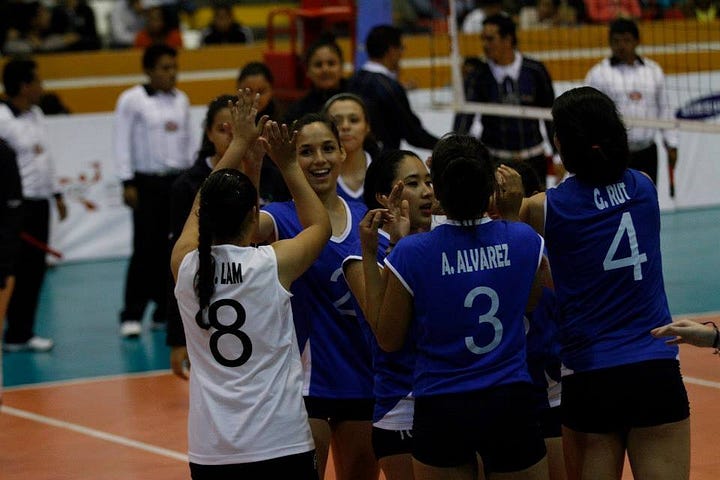Creating Cultures of Learning
Exploring High-Growth Cultures through Expectations, Language, and Routines
👋 Hi there, welcome to The Learning Dispatch! We explore creative formats from the world of learning. Created by TeamLogiQ.
If you’re here for the first time, welcome! Feel free to catch up with our previous editions:
🔗 Learning Through Gamification
Now, on to this week’s format!
Day one, and our new coach from Cuba had that 'what have I gotten myself into' look. Dreams of a new beginning had brought him to Guatemala: a shot at a decent paycheck and the challenge of transforming our young national volleyball team into a competitive force. At 14, I didn't grasp the full picture, but that first practice? I remember it like it was yesterday…
It was disastrous. The moment we started our warm-up laps, he was on edge, probably because we kept cutting corners. Then, as he introduced a new drill, he couldn't help but stop us every few minutes trying to fine-tune our form or technique. We played a short match, and all we heard was his whistle time and time again… Despite our best efforts to follow his lead, something was off.
Our learning culture was worlds apart from what he was used to in Cuba, then a volleyball powerhouse. Everything from our motivation and physicality to our dedication and approach was different. We weren't just cutting corners in the warm-up laps; it felt like we were doing it in many other ways, too…


Our coach was pretty much like having an AI tutor in our study group. Super smart and full of knowledge, but if you're not ready to ask the right questions or listen, that wisdom just hangs in the air, unused.
We had access to his vast expertise, but without the right cultural foundation to absorb and apply his coaching, his presence alone couldn't transform our team. This underscores a broader truth in education today: as AI-powered learning tools become increasingly accessible, the real challenge lies not in the technology itself, but in cultivating a culture that can harness its full potential. And that’s the format we’re exploring today.
📰 What’s the format?
Cultures of learning: a framework to build an authentic learning culture through mental habits1.
🎛️ What are the features?
There are many cultural forces that can shape how we learn. Today we’ll explore three: Expectations, Language, and Routines.
💡 Why does this matter?
In his article “AI Tutors will be held back by culture”, Henrick Karlsson predicts that soon we’ll be underwhelmed by the changes wrought by AI tutors in the education system.
Yes, people who live in high-growth cultures, and who are motivated to learn, will be able to leverage AI tutors to accelerate their progress. But the rest, lacking access to these cultures, will use the systems to distract themselves and wriggle out of work.
If we want to improve our capacity to help each other grow skilled, the key problem now is figuring out how to scale access to high-growth cultures.
Creating cultures of learning matter because even with the best curriculum, top-notch tools, and well-designed learning experiences, it all falls flat without a culture that motivates learners, promotes deep understanding, and supports ongoing inquiry and curiosity.
So let’s explore some of these high-growth cultural forces one by one.
1. Expectations
There’s a difference between: “Is your work done?” or “Where are you in your learning?”
A group of teacher researchers (Claxton, Chambers, Powell, & Lucas, 2011) sat in on classrooms to listen for just how prevalent teachers’ use of the words “work” and “learning” were. To their astonishment, “work” was used forty-nine times more often than was “learning.”
The language we use in schools is full with a lot of work-related metaphors: Students are issued workbooks, given work time or work periods, and are assigned seat work and homework.
If we view classrooms as workplaces, we might think that 'productivity' could be enhanced by incentivizing efficiency and superior outcomes, or in this context, higher test scores. However, this approach overlooks a crucial aspect: it doesn't necessarily equate to meaningful learning. The focus shifts to outputs rather than the value of the educational process itself. It focuses on the work vs the learning.
Metaphors matter, as well as our expectations of for learners. The way one frames a task often determines how one goes about accomplishing that task and what one is likely to get out of it.
2. Language
There’s a difference between: “Today we are going to learn about chemical reactions” and “Today as scientists we are going to be investigating how chemicals react under various circumstances...
In his book Making Learning Whole, David Perkins (2009) identifies a chief problem in much of school learning: we tend to teach a subject in terms of its elements, pieces, topics, and so on rather than engaging students in authentic activities such that we let them “play the whole game”.
If we teach about the subject rather than engaging learners as members of it, we are reinforcing the idea of the teacher as deliverer of information and student as passive receiver.
Now, learners won’t suddenly become mathematicians merely because we call them that one day. However, our language both conveys intention and cues behavior.
3. Routines
There’s a difference between a one-off activity and a routine that supports deeper learning and thinking until it eventually becomes a pattern of behavior.
Thinking routines are like maps for our minds, guiding us through the journey of learning. They're strategies, questions, or steps that turn into habits for learners, providing a framework to support their thinking. Initially, it's up to the teacher or facilitator to kick-start these routines, but over time, the goal is for learners to take the reins themselves. By integrating thinking routines into a learning experience, you equip learners with the necessary tools, structures and scaffolds to embark on deep, meaningful thinking on their own. This kind of thinking not only boosts their understanding but also prepares them for independent learning.
👉 [Important Pause:] Head over to Harvard’s Project Zero site with a whole list of Thinking Routines and brief explanations on how to use them.
The beauty of thinking routines lies in their adaptability. Creating a space where thinking is not just encouraged but expected requires giving learners the tools they need for this mental exploration. As these routines become more familiar and are applied across various scenarios, they evolve into natural behaviors. This transformation is key, as it shapes a culture where continuous, thoughtful inquiry becomes a way of life, laying the groundwork for lifelong learning.
🥁 Recommendations
Here are a few recommendations to apply these “mental habits” to your learning experiences:
Expectations
Remind your learners that the work is a means to an end, not an end in itself.
When the purpose of the task is on the learning, you should be more likely to provide choice and options as long as the learning is being achieved.
Learning-oriented experiences focus on descriptive feedback that informs learning, whereas a work-oriented experiences tend to give more evaluative feedback as a judgment on performance.
Language
Help learners come to see themselves not as outsiders looking in on a subject but as members of it.
Rather than learning about history, they become historians; rather than learning about science, they become scientists; rather than learning about literary criticism, they become literary critics…
Using the language of identity in the classroom signals to students that they need to activate certain applicable ways of thinking.
Routines
Choosing the best tool for the job involves asking, What kind of thinking do learners need to do with this content? How can I best engage them in that kind of thinking?
The ultimate goal of using thinking routines is for them to become patterns of behavior.
Explore this Toolkit with routines for digging deeper into ideas, investigating objects and systems, perspective-taking, and more…
🏷 Summary
To truly transform our learning landscapes, we must go beyond mere access to content and technology. Cultivating a culture that fosters growth, curiosity, and a deep-seated love for learning is key. By reshaping our expectations, refining our language, and establishing productive routines, we equip our learners not just for academic success, but for a lifetime of meaningful inquiry and exploration.
Our volleyball coach didn’t gave up on us. After a lot of initial frustration, he shifted his focus to the less visible aspects of the game: emphasizing the importance of the training process over mere results (expectations), exploring our perceptions of representing our national team and how it intertwined with our identities (language), and cultivating both physical and mental habits to enhance our skills as players (routines).
👉 Coming Up Next
In our latest poll, the topic that received the most interest was 'Internet Salons.' Stay tuned for our next feature, where we'll dive into the world of online communities dedicated to learning.
We value your feedback (suggestions, critiques, positive reinforcement, constructive ideas…) as well as your tips or suggestions for future editions. We’d love to hear about you in the comments.
→ Or just click the heart symbol. That always makes our day.
The ideas in today’s edition are inspired by the book “Creating Cultures of Thinking: The 8 Forces We Must Master to Truly Transform Our Schools” by Ron Ritchhart.


















